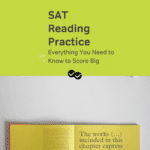After the Literature passage on the New SAT, you’ll see two History/Social Studies passages and two Science passages–typically alternated. These passages should be approached a little differently than the Fiction passage. Here’s what you need to know:
SAT Reading Nonfiction Tip 1: One of the History/Social Studies passages and one of the Science passages is going to include a graphic.
We’ll talk about how to deal with questions on graphics in the next section, but for now, I would suggest not focusing on the chart or graph at all when you are reading until you get to the question(s) on it. The questions might be very specific or more general, and you never know exactly what they are going to ask. There is going to be a lot more information on the graphic than you need to answer the question, so don’t waste your time until the question tells you exactly what you need to find.
SAT Reading Nonfiction Tip 2: One of the History/Social Studies passages is going to be from a U.S. Founding Document or the Great Global Conversation.
It’s particularly important to check the author and the date on these passages, which will appear in smaller font before the passage. You may be familiar with the author (“Oh hello there again, Dr. Martin Luther King or Harriet Tubman!”) or the time period in which it was written (“Hmmm, 1775 sounds suspiciously like the start of the American Revolution”). Although the questions will never rely on outside knowledge, some familiarity with the author or situation will orient you before you begin reading so you can get more out of the passage without having to piece together the clues.
SAT Reading Nonfiction Tip 3: Just because it’s non-fiction doesn’t mean the author won’t have a personal perspective.
The History/Social Studies passage may be something like a memoir; in this case, it may sound almost like a fiction passage. Or it might be a letter or a speech that is making a persuasive (and personal) argument. If it seems pretty personal, be prepared for questions that ask about the author’s feelings or attitudes. You can bet your bottom dollar there will be one or two.
SAT Reading: More on the History/Social Studies Passage
There’s a range of subjects that can be drawn on in these passages, but there tends to be a heavier focus on sociology, psychology, economics and political science. As a sampling, the official practice tests in the College Board guide have passages on the psychology of gift giving, ethical economics, public transportation, theories on education in 18th century America, growth of cities, speeches by Virginia Woolf and Elizabeth Cady Stanton on the roles of women, and the French Revolution.
SAT Reading: More on the Science Passage
Don’t be too intimidated by the Science passages, although they will often include some jargon, they are written for everyday people. However, at the same time don’t be lulled into a false sense of belief that a strong background in science won’t help you out here. It’s a lot easier to make sense of theories on the DNA double helix if you’ve studied them in class. If you are uncomfortable reading about science, we suggest reading some articles written for the everyday person on science topics. Scientific American, National Geographic, or Discover magazines will give you a good feel for the type of passages you might encounter on the SAT.
The Science passages pull from a range of topics in the natural sciences: this means earth science, biology, chemistry, and physics. A sampling from the Official Guide includes passages about DNA, the prospect of mining in space, the effect of the internet on our brains, ocean waves, evolution of birds, the disappearance of honeybees, genetic modification, and sources of volcanic eruptions.
The Takeaway
The SAT calls most of the nonfiction passages “informational passages” because this is precisely what they do: communicate information. Your job is to distill this information into its most important elements:
- the main idea
- any different theories or perspectives on the topic presented
- the examples used to support the topic
- the author’s conclusion about this topic
If you can do this, you will be prepared for almost all of the questions that follow.






Leave a Reply